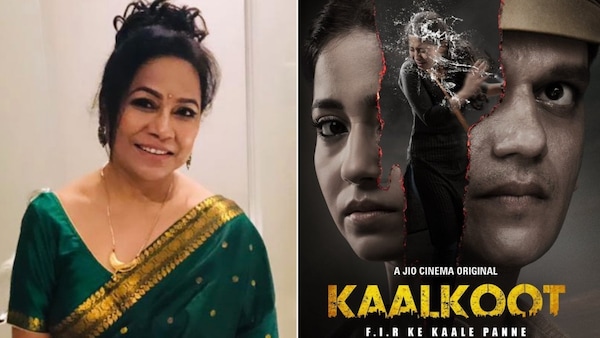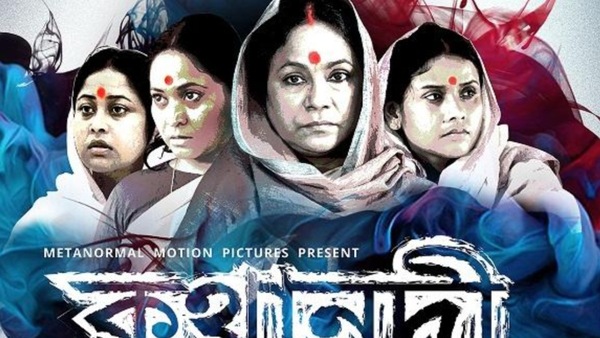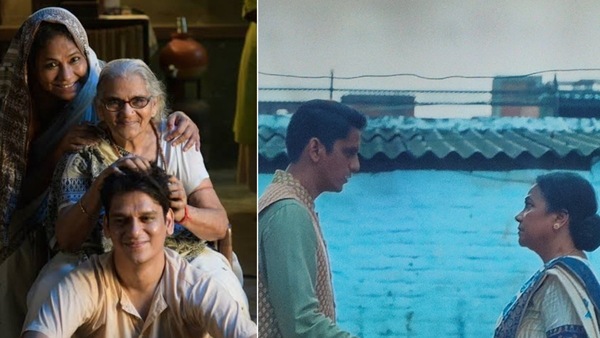Exclusive | Kaalkoot’s Seema Biswas: ‘OTT is a great medium, as long as it does not fall into the trap of trends’
The legendary actress plays Vijay Varma’s mother in JioCinema’s crime drama series Kaalkoot

Last Updated: 01.34 PM, Aug 11, 2023
Nearly three decades later, Seema Biswas’ name is still synonymous with her trailblazing performance in Shekhar Kapur-directed critically acclaimed biopic Bandit Queen. Cut to the latest, the National Award-winning actress continues to make a mark with some incredible characters on OTT and otherwise. Most recently, Seema appeared as the happy-go-lucky mother of an emotionally troubled cop, essayed by Vijay Varma, in JioCinema’s crime drama series Kaalkoot.
Before acting in the Sumit Saxena series, Seema played key roles in shows like Leila, Sir Madam Sarpanch, Human and Code M. In an exclusive interview with OTTplay recently, the legendary actress, who hails from Assam, spoke about her experience of working with Vijay in Kaalkoot, why she thinks OTT content runs the risk of falling prey to trends, her take on strong female characters in the digital space, the fate of Assamese cinema, and more. Excerpts:

Q. How would you describe your experience of being part of Kaalkoot, especially working with Vijay Varma?
A. The entire unit of Kaalkoot - including director Sumit and show-runner Karan Singh Tyagi - was very passionate, energetic and involved. In the show, Vijay plays the role of a sincere and honest police sub-inspector, named Ravi Shankar Tripathi, who is going through a lot of mental stress and complications in his life. From Day 1, Vijay was very clear about the character he was portraying on screen. The manner in which he underplays his internalisation is his speciality. Vijay is effortlessly brilliant on screen. Even on the set, he is someone who speaks less, peaceful and cool-headed.
I play the mother of Vijay’s character in the series. She is the complete opposite of him in terms of character and personality. She is a caring and fun-loving single mother, who is concerned about her son’s well-being and wants him to get married soon.
Q. Do you believe that OTT as a medium has brought about a positive change in the film industry? What’re your views on the growing popularity of the digital space?
A. My OTT journey began with Netflix’s Leila [a dystopian drama web series directed by Deepa Mehta]. In terms of ambience, treatment and the overall process of making a series, I feel it’s more or less the same. Maybe, the number of days for shooting a web series is more than that of a film, which further increases for the protagonist and lead characters - sometimes, going on until three months at a stretch. But such differences do not necessarily reflect on the performance or in audiences’ reactions. The most important factor for the shows and films streaming on OTT is their holding capacity, which again may or may not work in favour of the audience. There have been times when people have compromised on their sleep while binge-watching a show. So, that’s a minus, I feel. As an audience member, I have often found myself consuming OTT content non-stop. Why? Because, the curiosity to find out what’s next is so much that I end up watching all the episodes in one go. I am not somebody who’ll pause in between and then start watching it later again. I usually sit through four-five hours and finish it. These factors also speak a lot about how OTT is a writer’s medium. It’s all about how the story is narrated.
That said, OTT is a relatively new format or medium, and thus the growing interest in it is justifiable. But we also have to keep in mind that shows and films don’t fall victim to a specific style or particular genre - be it violence or murder mystery. In terms of characters as well, nobody likes to be cast in the same kind of roles over and over again. For instance, I myself have turned down quite a few mother’s roles, because those looked very similar to what I have already done or could have done on television serials that also pay well. If you look at it, the storyline and complexity of the character I play in The Family Man 2 are very different from that in Kaalkoot.
It’s also a huge responsibility for the director to be able to hold the audience’s attention for long hours. Usually, the duration of a film is say two or two-and-a-half hours, and beyond that the viewer might reach a saturation point. So, the script or the screenplay has a huge role to play in the digital medium.
A big plus point on OTT, however, is that it has given due exposure and opportunity to many good actors in the industry, who didn’t get the same in films earlier. That’s a significant advantage of long-format content.
Having said that, I also feel the beauty of real cinema lies in watching a film on the big screen. It’s a pity that nowadays a lot of good films are released on OTT, instead of the theatres. The general sentiment now is that anyway the movie is going to be eventually released on OTT, so why not wait! So, that’s a bit sad.
Q. You mentioned that OTT is providing the kind of opportunity to actors now that films could never give in the past. Do you also feel that female characters are more fleshed out now? What is it that the digital space should be wary of?
A. Be it male or female characters, the work or existence of a lot of actors go unnoticed in films. OTT, on the other hand, is a game-changer, particularly in terms of footage or the length of a character. Even actors like Pankaj Tripathi and Nawazuddin Siddiqui have gained more prominence through OTT. Here, every role is fleshed out and there is enough scope to portray the different layers and emotional highs and lows of a character, allowing actors to showcase their talent.
Cut to strong female characters, earlier only one or two good women-oriented films could be seen in a decade. But now we see several films and series, where women play the protagonists or lead characters. There are suitable roles for even a 90-year-old actor in long-format content, but in films a prominent hero or a heroine becomes a prerequisite to pull the audience to the cinemas. Unlike in the West, to get good roles after the age of 30-35 is a rarity in India. Thankfully though, the digital space is changing that concept with strong narratives and relevant storylines.
Often foreign language films are found to dabble in out-of-the-world stories, while there are also narratives that are realistic and believable. In India though, we love to follow a trend. For instance, there was a time when three-word, four-word movie names became very popular - like Dilwale Dulhania Le Jayenge and Kabhi Khushi Kabhie Gham… So, as long as OTT does not fall into the trap of following trends - be it murder mysteries or stories about serial killers - and rather concentrate on narrating a variety of good, impactful and relatable stories, it’s going to sustain well. The focus should be on building a project, which is pertinent and interesting from the actor, writer and director’s point of view. Sometimes, even a literary or poetic style of narrative can make a curious show. OTT is a great medium, but it shouldn’t be misused or trapped in a trend. The focus should be on telling a story rather than finding ways to cover five hours to complete the show.
Q. Although not spoken about as much in the mainstream yet, Assamese films and OTT shows have made considerable progress in recent times. What is it that you think is working in favour of the industry and what does it still lack?
A. Yes, things have changed a lot over the past years, as compared with earlier times when making a film in the state involved a lot of financial constraints and struggles. Of course, making a movie is an expensive task. And if somebody is financing the project, it is expected to meet a certain profit margin, at least. If even the minimum costs are not covered, how will there be a next project? It’s a filmmaker or a director’s responsibility to do their homework and carefully research the topic before making the movie.

We have seen how that helps - be it Rima Das’ Village Rockstars, which took about four years to make, or Bhaskar Hazarika’s Kothanodi, which also took several years. These are well-researched, original, organic and independent projects that have given a new recognition to Assamese cinema across India, as well as internationally. These are the kind of films that can be compared with the outstanding works that we see from Iran, Korea and not just Hollywood. So, I would suggest when you are making original films, instead of hopping onto a rat race, maybe invest a little more time and effort in further exploring the subject, so that the final outcome is more well-rounded and can be taken to the global platform.
But at the same time, it’s also the responsibility of the Assamese audience to support Assamese films. I have noticed that when a Malayalam movie is released in Mumbai, Malayalis in the city make it a point to watch the film, no matter what. That sentiment or sense of support is lacking among the Assamese audience. We are almost always ready with an excuse to not step out of the house, unless of course it’s a blockbuster film. Many a time, if you are known to the makers and for some reason he or she is not invited for the premiere show, people take offence to that as well. If you can recharge your phone or cable TV connection, why are you so reluctant to pay a little for the tickets to watch the film at the theatres?
If people from the state are not watching their films, where will the money come from? Original independent films also need to be acknowledged and supported equally for the industry to claim its space on the global landscape. No doubt, Assamese cinema is technically far advanced now. But we should focus more on making independent cinema, which is also commercially viable. Look at Mani Ratnam’s movies!

On OTT, we get to see stories that are beyond our imagination, but at the same time they are believable. I am not saying we should jump into making shows like Money Heist, but curious and innovative scripts are always welcome. For some OTT shows, makers are coming up with narratives that would inspire you to empathise even with a negative character. I think that’s an interesting take on stories.
Q. What’s your take on film criticism?
A. If a film is badly made, one should speak about it in a review. But critiquing a film or a show does not mean one goes on and on only about the negative aspects of it, which in the following days spills over to talk shows on television and articles in newspapers. Such condemnation can have a negative impact on the creative process of filmmaking and morally crush the makers. What we need is constructive criticism, not denunciation. Too much scrutiny of anything is bad. Interestingly though, many people would rather read these pieces or watch debates about the film on TV, but not go watch it for themselves.
Q. Tell us about your upcoming projects…
A. I am working on a Tamil web series. Then, there is another series in the works. I try not to repeat myself and do as many different characters as possible. I have also just completed shooting for a Bengali film, called Mon Potonga, and will be part of Kookie Gulati’s Visfot, which marks Fardeen Khan’s comeback to films. Recently, I completed shooting for a cop drama with Amit Sadh. The Hindi remake of Suriya’s Soorarai Pottru, starring Akshay Kumar, in which I play a key role is in the post-production stage. Then, there is an ensemble cast web series, titled Bindiya - featuring Sheeba Chadha, Tannishtha Chatterjee, Saurabh Shukla and Ranvir Shorey, among others.
Subscribe to our newsletter for top content, delivered fast.

